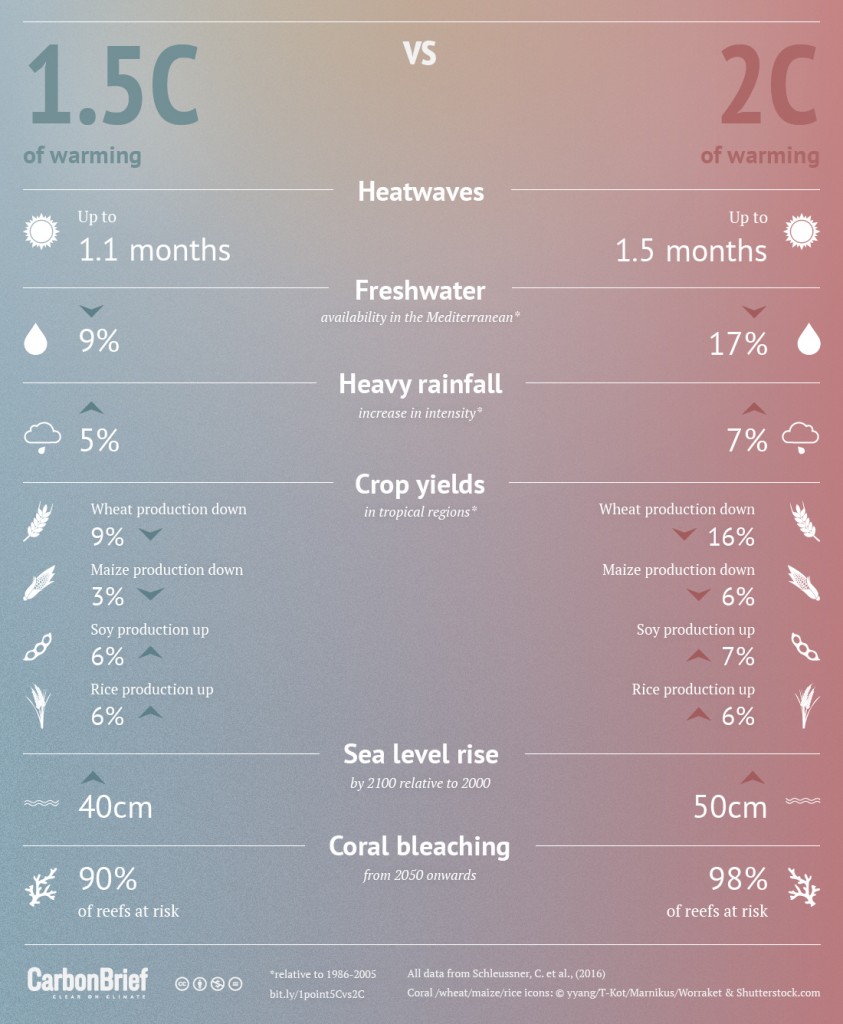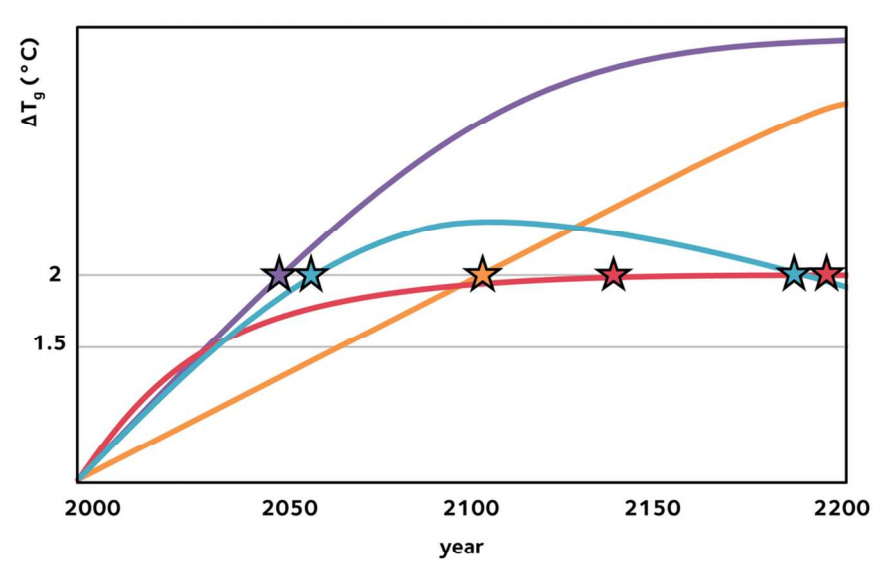Dr. Rachel James, Dr Joeri Rogelj, from Carbon Brief.
Our new review paper, published today in WIREs Climate Change, looks at the tools scientists have available to compare climate signals at different warming levels, where the field is headed next and how much can be done in time for the Special Report on 1.5C.

Using 11 climate models, the authors looked at how each of the impacts plays out globally, as well as in 26 different regions. This is important since the world won’t warm at the same pace everywhere, the paper notes.
Some of the most dramatic differences occur with heat extremes, with heatwaves in the tropics lasting up to three months with 2C warming, compared to two months with 1.5C. The paper says:
High northern latitudes are expected to see some of the biggest increases in heavy rainfall, with the maximum over a five-day period rising by 7% for 2C warming, compared to 5% for 1.5C.
At the same time, water scarcity in the Mediterranean is likely to be twice as severe at 2C than at 1.5C, with climate-induced shortfalls of 17% compared to 9% (relative to 1986-2005 levels).
The study shows global sea level rising 50cm by 2100 with 2C of warming, compared to 40cm for 1.5C (both relative to 2000). Warming of 2C would also put 98% of the world’s reefs at risk of coral bleaching from 2050 onwards, compared to 90% for 1.5C.
Climate change impacts on crops are complicated, depending a lot on the crop in question and where in the world you’re looking. Schleussner tells Carbon Brief:
The new study’s results are in line with previous research suggesting an average reduction of about 6% in global wheat yields per degree of warming, Schleussner tells Carbon Brief.
Tropical regions, such as West Africa, Southeast Asia, Central America and northern South America, are likely to be worst affected, the study notes, with yields of wheat and maize set to decline.
The study accounts for the potential of higher CO2 to have a positive effect on crop yields, particularly in high-latitude regions, but notes this is still not well understood.
Scientists have used a number of methods to extract climate signals at specific warming levels from existing experiments. Whilst there are very few model runs which hold warming to below 1.5C or 2C, many of them cross those thresholds at some point in time. This allows scientists to compare the “transient” climate response at the point at which we pass 1.5C and 2C.
Studies so far that have used this approach to compare impacts at 1.5C and 2C of warming suggest that half a degree could make a very big difference. But there is significantly more we could do on this front. Most of the work so far to analyse the “transient” impact of different levels of warming do so for 2C and/or 4C, but not 1.5C.
In other words, we could quite quickly generate much more information about the initial response to 1.5C or 2C, just by analysing the data we already have.
One issue with this “transient” approach, however, is the limited number of years of data available at 1.5C and 2C. This makes it difficult to explore differences in extreme events, which are, by definition, rare. New model experiments are currently being run to generate large ensembles at 1.5C and 2C to try to address this problem. These experiments are part of a project called HAPPI (Half a degree Additional warming, Prognosis and Projected Impacts), which aims to better understand extreme weather in a changing climate. Importantly, it looks like this new data source will be in time for studies to be included in the IPCC’s Special Report.
It gets more complicated, however, when we try to take into account the uncertainties associated with trying to stabilise or hold temperatures at 1.5C or 2C over long timescales.
The long term implications of 1.5C or 2C might vary, depending on the path taken to get there. As shown in the figure below, we could reach 2C or 1.5C very quickly (purple), or take much longer (red, yellow). Global temperature might also temporarily overshoot 1.5C or 2C before stabilising (blue).

We need to take the “pathway” into account because different routes to the end-goal could have distinct climate impacts. This is partly due to lags in the system: the climate will continue to respond to CO2 emissions for decades.
Reducing CO2 might itself have a distinct influence on the climate. Mitigating to 1.5C or 2C could require large scale changes in land use, such as afforestation, or growing crops for bioenergy, which could modify regional climate.
Finally, models might struggle to represent potential thresholds or “tipping points” in the climate system, such as the irreversible collapse of the Greenland Ice Sheet. Processes that can act to further amplify warming, such as permafrost thaw, may also be absent or incompletely represented. This is particularly pertinent if the triggers for such “tipping points” exist between 1.5C and 2C.
Looking forward
There are clearly a lot of uncertainties associated with modelling climate signals at 1.5C and 2C, and scientists are working with imperfect data sources, with a rapidly approaching deadline. The challenge is great, but our paper suggests a number of promising directions which might provide information in time for the IPCC Special Report.

Acknowledging that capping warming at 1.5C is preferable to 2C is one thing, but it’s important to talk about the realities of getting there. And the scale of the challenge is immense.
On current emissions, the carbon budget for 1.5C will effectively be blown in about four and a half years, as our graphic above shows (Note: figures are based on 2014 emissions).
The consequence of this is that any realistic possibility of limiting warming to 1.5C in the long term means overshooting the target and somehow coming back down. Schleussner tells Carbon Brief:
But doing so involves relying on being able to “suck” carbon dioxide out of the air, using so-called negative emissions technologies (NETs). Carbon Brief ran a special series of article last week looking in-depth at possible approaches and how feasible experts think they are.
Even if overshooting and coming back down to 1.5C were technically possible, there’s no guarantee the consequences for ecosystems would be the same as if we hadn’t cross the 1.5C boundary at all. Whether or not climate change impacts are “reversible” is a very important research topic right now, says Schleussner.
Today’s study is an important first step to understanding the real-world consequences of what countries agreed to do, in principle, in Paris.
While it lays out the scientific reasoning behind a 1.5C target, the question of if and how we get there is part of a far bigger conversation, one that’s particularly pertinent as nations gather in New York this week to reaffirm their collective commitment.
From 21 April 2016 Carbon Brief article:
Reality check
The sheer scale of the contrast between climate impacts 1.5C and 2C came as “quite a surprise” to the authors, Schleussner tells Carbon Brief:
“Our results clearly show that the difference between 1.5C and 2C is not only a matter of gradual change.” So, should 2C remain the reference point for “dangerous anthropogenic interference in the climate system” or are impacts at 1.5C severe enough to warrant a rethink?
While science can make sure there’s as much evidence as possible, that’s a conversation that extends further than the scientific community, say the authors in the paper:
“Although the assessment of levels of dangerous interference is primarily a political process that requires value judgements and depends on different world views, it needs to be informed by the best available science outlining the impacts of climate change and mitigation efforts.”

Acknowledging that capping warming at 1.5C is preferable to 2C is one thing, but it’s important to talk about the realities of getting there. And the scale of the challenge is immense.
On current emissions, the carbon budget for 1.5C will effectively be blown in about four and a half years, as our graphic above shows (Note: figures are based on 2014 emissions).
The consequence of this is that any realistic possibility of limiting warming to 1.5C in the long term means overshooting the target and somehow coming back down. Schleussner tells Carbon Brief:
But doing so involves relying on being able to “suck” carbon dioxide out of the air, using so-called negative emissions technologies (NETs). Carbon Brief ran a special series of article last week looking in-depth at possible approaches and how feasible experts think they are.
Even if overshooting and coming back down to 1.5C were technically possible, there’s no guarantee the consequences for ecosystems would be the same as if we hadn’t cross the 1.5C boundary at all. Whether or not climate change impacts are “reversible” is a very important research topic right now, says Schleussner.
Today’s study is an important first step to understanding the real-world consequences of what countries agreed to do, in principle, in Paris.
While it lays out the scientific reasoning behind a 1.5C target, the question of if and how we get there is part of a far bigger conversation, one that’s particularly pertinent as nations gather in New York this week to reaffirm their collective commitment.
